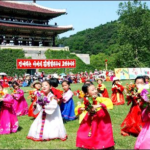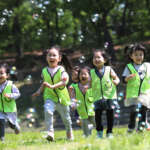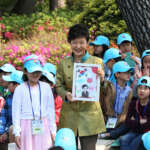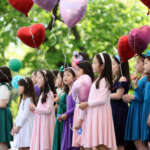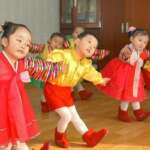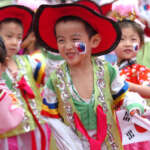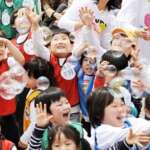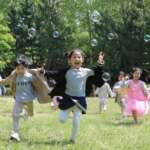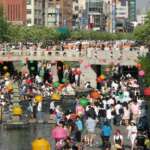When did the Children’s Day in South Korea start?
About Children’s Day in South Korea Holiday
Celebrate the magic of childhood with South Korea’s vibrant Children’s Day, a special national holiday observed every year on May 5th. This joyful occasion epitomizes the country’s deep appreciation for the happiness, innocence, and well-being of its youngest generation. From bustling parks to theme parks and cultural festivals, families across South Korea come together to indulge children with gifts, outdoor activities, and memorable experiences that emphasize love and care.
Children’s Day in South Korea offers a unique glimpse into the nation’s valuing of family bonds and community spirit. Visitors can explore a wide array of festive events, including traditional performances, exhibitions, and outdoor adventures, all designed to make children feel cherished. Whether you’re traveling through Seoul, Busan, or smaller towns, witnessing how South Korea celebrates its children provides a wonderful opportunity to immerse yourself in the country’s rich cultural heritage and family-oriented traditions. Planning a trip around this holiday not only enriches your travel experience but also highlights the universal importance of nurturing the next generation.
Children’s Day in South Korea: A Celebration of Joy, Culture, and Family
Imagine a day dedicated entirely to making kids feel special—a day filled with laughter, gifts, and heartfelt attention. In South Korea, that day is Children’s Day, celebrated annually on May 5th. It’s more than just a holiday; it’s a vibrant reflection of the nation’s cultural values, deep-rooted traditions, and modern social dynamics. Whether you’re a traveler, a parent, or simply a culture enthusiast, understanding what makes Children’s Day so unique in South Korea offers a fascinating glimpse into the country’s heart and soul.
Brief Overview and Significance
Children’s Day in South Korea holds a special place in the national calendar. It is a day when families come together to honor the innocence and happiness of their children, emphasizing the importance of nurturing the next generation. Schools, parks, and amusement parks buzz with activity as children indulge in fun activities and receive thoughtful gifts. But beyond the festivities, this holiday also symbolizes societal appreciation for children’s well-being and future prospects.
Key Takeaways
- Celebrated annually on May 5th since 1975, making it a national holiday.
- Originates from a broader movement to recognize children’s rights and happiness.
- Celebrated through family outings, cultural performances, and special school events.
- Includes traditional symbols like balloons, toys, and floral decorations.
- Reflects Korea’s blend of traditional values and modern celebrations.
History and Origin of Children’s Day in South Korea
Roots in Post-War Society
The roots of Children’s Day in South Korea trace back to 1923, during the Japanese colonial period, when the first Children’s Day was introduced as a way to promote children’s rights and appreciation. However, the modern celebration as we know it today took shape after South Korea’s independence, especially in 1975, as the government aimed to bolster family bonds and social cohesion during a period of rapid economic development.
Evolution Over Time
Initially, Children’s Day was mainly a family-centric holiday marked with small family gatherings. Over the decades, it grew into a nationwide celebration with public events, school competitions, and cultural performances. It evolved alongside Korea’s economic boom, which allowed more elaborate festivities and increased focus on children’s education and happiness. Today, it represents not just a day off but a deeper acknowledgment of children’s rights and societal support.
Historical Context
During the 20th century, particularly post-Korean War, the country placed increasing emphasis on children’s welfare. Governments began initiatives to improve education, healthcare, and safety for children. The creation of Children’s Day was a direct response to these efforts, emphasizing the importance of nurturing future leaders and citizens. As South Korea rose to global prominence, the holiday reflected a balance of traditional Confucian values with modern aspirations for societal progress.
Cultural Significance and Meaning
Core Values Embedded in the Holiday
At its heart, Children’s Day embodies care, respect, and hope. It highlights Korea’s cultural respect for elders and the importance of family, extending that reverence to children as the future of society. It’s a day when parents and communities express gratitude and encouragement to young ones, reinforcing the societal belief that investing in children today ensures a prosperous tomorrow.
Traditional Elements and Symbols
The holiday is rich with symbols of purity and innocence—bright balloons, colorful toys, and floral decorations like roses and lilies. These decorations symbolize hope and new beginnings, echoing the traditional Korean values of nurturing growth and harmony. It’s not uncommon to see children dressed in hanbok, traditional Korean attire, during special ceremonies, blending modern celebrations with cultural heritage.
Symbols and Decorations of Children’s Day in Korea
Symbols play a vital role in conveying the festive spirit. Brightly colored balloons and ribbons adorn streets, parks, and homes, representing joy and hope. Toy figures, especially plush animals and miniature cars, are common gifts exchanged between families and friends, symbolizing love and appreciation.
Flowers, notably roses and lilies, are frequently used in decorations, symbolizing purity, love, and new beginnings. In some regions, traditional paper lanterns are crafted, representing guiding lights that lead children into a bright future. These vibrant symbols collectively create an atmosphere of celebration that’s visually cheerful and emotionally meaningful.
Traditional and Modern Celebrations
Family Outings and Community Events
One of the most iconic traditions on Children’s Day is family outings. Parents often take their children to amusement parks, zoos, or scenic spots like Namsan Tower in Seoul or Jeju Island. These excursions are more than just fun—they serve as bonding experiences and reaffirm family ties. Parks are filled with children playing games, flying kites, and enjoying picnics, turning the entire country into a playground.
School and Cultural Festivals
Many schools hold special performances, talent shows, and art exhibitions to honor their students. Children showcase their talents through dance, singing, or painting competitions. Cultural festivals featuring traditional music, dance, and crafts also take place, helping children connect with their heritage while celebrating their creativity.
Special Gifts and Acts of Kindness
Giving gifts is a core part of Children’s Day. It’s customary for parents and relatives to present children with toys, clothes, or educational supplies. Some communities organize charity drives, encouraging older students and adults to donate items or funds to support underprivileged children—highlighting the holiday’s inclusive spirit and social responsibility.
Street Parades and Public Celebrations
In major cities, colorful parades featuring floats, costumes, and performances become focal points. These vibrant displays attract crowds and foster community pride. Local governments often organize outdoor concerts, fireworks, and dance performances, making it a city-wide festival that people of all ages enjoy.
Food and Cuisine on Children’s Day
Food plays a delightful role in the festivities. Traditional Korean dishes like tteok (rice cakes), jeon (pancakes), and sweet treats such as yakgwa (honey cookies) are enjoyed widely. Children especially indulge in colorful candies, jellies, and snack foods that resemble playful shapes and characters, adding to the holiday’s cheerful atmosphere.
A popular tradition is preparing special meals that emphasize nutrition and visual appeal, often decorated with cute motifs. Some families make a meal called ‘chungguk,’ a playful combination of rice, vegetables, and meats shaped into happy faces or animals—making mealtime fun and meaningful.
Attire and Costumes During Children’s Day
Many children wear their best clothes or traditional Korean outfits, like hanbok, for special ceremonies and photos. These garments are often brightly colored and ornamented, symbolizing good fortune and happiness. The hanbok’s elegant designs and vibrant colors contribute to the festive atmosphere, blending tradition with contemporary styles.
In addition, some children participate in costume contests, dressing up as their favorite characters, historical figures, or traditional folk heroes. These costumes promote creativity and cultural pride, creating photo-worthy moments that families cherish forever.
Geographical Spread and Regional Variations
While Children’s Day is celebrated nationwide, certain regions add unique local flavors. In Seoul, festivities are grand, featuring large-scale parades, concerts, and exhibitions. The capital’s vibrant urban environment provides a dynamic backdrop for diverse events that attract visitors from around the world.
Elsewhere in Korea, places like Busan and Daegu host local festivals, street performances, and nature excursions. For example, Jeju Island’s natural beauty makes it a perfect spot for outdoor adventures like hiking and beach outings, making the celebration more nature-oriented.
In rural areas, community-driven events such as traditional folk games, craft workshops, and storytelling sessions are common. These regional variations showcase Korea’s rich cultural diversity, emphasizing community bonding and traditional practices.
Regional Differences in Celebrations
| Region | Unique Celebrations |
|---|---|
| Seoul | Large parades, concerts, and city-wide festivals |
| Busan | Beach festivals and outdoor markets |
| Jeju | Nature outings, cultural workshops |
| Rural Areas | Traditional folk games, storytelling festivals |
Modern-day Observations and How the Holiday Has Evolved
Modern Adaptations of Children’s Day
Today, Children’s Day in Korea is more than traditional festivals; it’s a social phenomenon. With the advent of technology, digital campaigns, and social media, children’s happiness is celebrated globally. Many brands launch special products and campaigns targeting children, blending commerce with heartfelt messages.
Digital and Virtual Activities
During recent years, especially during the COVID-19 pandemic, the holiday adapted with virtual events—online storytelling sessions, virtual museum tours, and digital art contests. These innovations helped families keep the festive spirit alive while staying safe.
Inclusive Celebrations
More recently, there’s been an emphasis on inclusivity—raising awareness about children with disabilities, fostering equality, and promoting mental health. Events and campaigns are designed to ensure every child feels loved and supported, reflecting modern societal values.
Integration with Global Movements
Korea also aligns its Children’s Day celebrations with global movements celebrating children’s rights, such as UNICEF campaigns. This international cooperation underscores Korea’s commitment to nurturing compassionate and globally minded youth.
Interesting Facts and Trivia About Children’s Day in South Korea
Did you know that in South Korea, Children’s Day is the second most important public holiday after Lunar New Year? It’s a day when millions of parents indulge their kids with gifts, and entire cities turn into playgrounds of fun.
Another interesting fact is that many Korean celebrities and influencers participate in Children’s Day campaigns, sharing messages or organizing charity events. This adds a modern celebrity-driven vibe to the celebration, making it more engaging for the youth.
Interestingly, some schools incorporate environmental lessons into their Children’s Day activities, teaching students how to protect nature, reflecting Korea’s eco-conscious shift.
Legends and Myths Surrounding Children’s Day
While modern celebrations are largely secular, some traditional stories and myths have woven into the holiday’s fabric. One popular legend involves the god of learning and protection, Bokjoo, who is believed to watch over children and grant wisdom and health.
According to folklore, during ancient times, children would write wishes on paper lanterns and release them into the sky, believing that the gods would grant their wishes for happiness and success. These stories continue to inspire modern festive customs like lantern-making and wish-sharing.
Social and Economic Impact
Children’s Day significantly boosts local economies—shop sales for toys, clothes, and treats surge around this time. Amusement parks, theaters, and travel agencies see increased patronage, turning it into a mini-holiday for tourism and commerce.
For businesses, it’s a prime opportunity for marketing aligned with family values. Many companies release special products or host sponsored events, which not only drive sales but strengthen brand recognition among families.
Moreover, the holiday fosters social cohesion. Community events promote volunteerism and charity, inspiring societal bonds and public support for children’s welfare. It also encourages intergenerational bonding, bridging the gap between young and old through shared traditions.
Environmental Considerations
As awareness of environmental sustainability grows, recent Children’s Day celebrations emphasize eco-friendly practices. Cities promote waste reduction, recycling, and the use of biodegradable decorations. Many organizations and schools organize clean-up campaigns after festivities, reinforcing the importance of caring for the environment even during celebrations.
Global Relevance and Why It Matters Outside Korea
Children’s Day in Korea isn’t just a national event; it offers a universal lesson in valuing children’s happiness and rights. As families worldwide grapple with balancing modern pressures and childhood innocence, Korea’s approach serves as a model of combining tradition with modernity.
International travelers or global educators can gain insights from Korean Children’s Day. It underscores the importance of family bonding, cultural pride, and societal support—elements that resonate universally. Participating in or observing the holiday can deepen cross-cultural understanding, fostering global compassion for children worldwide.
Other Popular Holiday Perspectives
Some critics argue that commercialism can overshadow the holiday’s true purpose, and that more emphasis should be placed on mental health and education. Others see Children’s Day as a reminder for policymakers to focus on child welfare more year-round, beyond just one day.
Regardless, Children’s Day continues to evolve as a dynamic celebration that reflects societal values, cultural heritage, and aspirations for a future where every child is cherished and empowered.
Final Thoughts: Why You Should Experience Children’s Day in Korea
If you’re eager to witness a nation called to celebrate its future—that’s its children—then Korea’s Children’s Day is a must-see. The infectious joy, heartfelt traditions, and vibrant displays offer tourists a unique window into Korean culture. Whether mingling with families at a local park, enjoying cultural performances, or simply observing the smiling faces of children, you’ll leave with a renewed appreciation for the universal innocence and hope that children bring to our world.
So, why not plan your visit around May 5th? Dive into the local celebrations, learn about Korea’s rich heritage, and even participate in some traditions. Not only will you enrich your travel experience, but you’ll also gain a deeper understanding of how Korea values its youth and future generations. Remember—every child’s smile is a testament to a society invested in happiness, growth, and harmony. Let’s celebrate that together.
How to Say "Children’s Day in South Korea" In Different Languages?
- Arabic
- عيد الأطفال في كوريا الجنوبية (ar-EG)
- French
- Fête des enfants en Corée du Sud (fr-FR)
- German
- Kinderfest in Südkorea (de-DE)
- Hindi
- दक्षिण कोरिया में बाल दिवस (hi-IN)
- Indonesian
- Hari Anak di Korea Selatan (id-ID)
- Italian
- Festa dei Bambini in Corea del Sud (it-IT)
- Japanese
- 子どもの日 (こどものひ) in 韓国 (ja-JP)
- Korean
- 한국 어린이날 (ko-KR)
- Mandarin Chinese
- 韩国儿童节 (zh-CN)
- Portuguese
- Dia das Crianças na Coreia do Sul (pt-BR)
- Russian
- День ребёнка в Южной Корее (ru-RU)
- Spanish
- Día del Niño en Corea del Sur (es-ES)
- Turkish
- Güney Kore'de Çocuk Bayramı (tr-TR)
- Vietnamese
- Ngày trẻ em ở Hàn Quốc (vi-VN)
- Zulu
- Usuku Lwabantwana eNingizimu Korea (zu-ZA)
Children’s Day in South Korea Also Called
Children's Day in South Korea is also called "Eorininal"Countries where "Children’s Day in South Korea" is celebrated:
FUN FACT:
In year 1923, Children’s Day in South Korea is celebrated on May 5 for the first time.HOLIDAY CHECK: We strive for accuracy and fairness. But if you see something that doesn't look right, please click here to contact us!
Travel Recipes, Food and Cuisine
Celebrating Children's Day in South Korea: Food, Cuisine, and Culinary Traditions
In South Korea, Children's Day (어린이날, Eorininal) is a treasured national holiday celebrated every May 5th, dedicated to honoring and nurturing the well-being of children. As part of its vibrant festivities, families indulge in special foods and traditional treats that symbolize health, happiness, and prosperity. This article explores the rich culinary landscape of Children’s Day in South Korea—from signature dishes and regional variations to creative recipes and presentation ideas—offering a flavorful journey into this joyful holiday.
Food and Cuisine - Children's Day in South Korea
Signature Dishes: The Heart of Children's Day Celebrations
Food plays a central role in South Korea's Children’s Day celebrations, with certain dishes regarded as symbols of well-being and happiness for children:
- Jeon-eo-jeon (Korean Pancakes with Seafood or Vegetables): Crispy, savory pancakes often enjoyed by families, representing good health and longevity. These are served with dipping sauces during festive gatherings.
- tteok (Korean Rice Cakes): Specially crafted rice cakes such as baekseolgi (white steamed rice cake) for purity and prosperity, and colorful tteok varieties symbolize joy and vitality.
- Fruits and Candy Arrangements: Brightly colored fresh fruits and traditional Korean candies like yeot (Honeyed Taffy) are common delights for children, emphasizing sweetness and happiness.
- Kids’ Favorite Snacks: Modern treats like choco pies and fruit gummies are also popular, blending traditional and contemporary flavors.
- Jeju Island: Known for fresh seafood, pancakes incorporate local specialties like abalone or seaweed.
- Gyeonggi Province: Emphasis on rice cakes flavored with chestnut or sesame for auspicious symbolism.
- Busan and the Southern Coast: Seafood-heavy pancake variations and spicy side dishes reflect local culinary traditions.
- Mix flour, eggs, salt, and pepper to form a smooth batter.
- Add seafood, vegetables, and green onions, ensuring even distribution.
- Heat oil in a pan over medium heat, then pour in batter to form pancakes.
- Cook until golden brown on both sides, then serve with a soy-vinegar dipping sauce.
- Gluten-Free Seafood Jeon: Use chickpea or rice flour for a gluten-free version.
- Vegan Pancakes: Replace eggs with flaxseed or aquafaba, and omit seafood for vegetable-friendly options.
- Spicy Variations: Incorporate Korean chili flakes (gochugaru) into the batter for a kick.
- Use fresh seafood and vegetables for vibrant taste.
- Ensure the oil is hot enough so pancakes become crispy on the outside.
- Adjust thickness based on desired pancake size and texture.
- Use colorful platters and arrange pancakes in festive patterns with edible flowers or fruit garnishes.
- Display rice cakes in tiered baskets or on decorated trays with ribbons and traditional Korean motifs.
- Incorporate playful elements like themed cupcake toppers or children's character figurines to enhance visual appeal.
- Opt for baking or steaming instead of deep-frying to reduce oil consumption.
- Use whole grain flours or incorporate superfoods like spirulina for added nutrients.
- Include a variety of colorful vegetables to boost fiber and antioxidants.
- Gluten-Free: Rice flour, chickpea flour, and cornstarch.
- Vegan: Egg replacements such as flaxseed meal or commercial egg replacers; plant-based seafood alternatives.
- Lactose-Free: Dairy-free dipping sauces and plant-based oils.
Regional Variations in Children's Day Cuisine
While the core celebratory foods are widely enjoyed across South Korea, regional flavors add unique twists:
Recipes for Children's Day: Traditional and Contemporary Flavors
Classic Holiday Recipes
Seafood Jeon (Korean Pancakes)
| Ingredients | Quantity |
|---|---|
| Flour (wheat or chickpea) | 1 cup |
| Fresh seafood (shrimp, squid) | 200g, chopped |
| Green onions | 2, chopped |
| Vegetables (carrots, zucchini) | 1/2 cup, julienned |
| Eggs | 1 |
| Salt and pepper | To taste |
| Oil for frying | As needed |
Preparation Tips:
Modern Twists on Traditional Flavors
For a contemporary take, consider substituting ingredients or adding new elements:
Preparation and Cooking Tips
To achieve authentic flavor and texture:
Pairings and Festive Presentation
Complementary Drink and Side Dish Pairings
| Dish | Suggested Pairing |
|---|---|
| Seafood Jeon | Cold barley tea (bori-cha) or light rice wine (makgeolli) |
| Rice Cakes | Sweet honey syrup or cinnamon infusion |
Decorative and Festive Presentation Ideas
Nutritional and Dietary Considerations
Healthier Options for Children's Day Dishes
Ingredient Substitutions for Dietary Restrictions
For further insights, consult reputable sources like Korean Food Foundation and Maangchi's Culinary Guides, which offer detailed traditional recipes and cultural context.
Conclusion
Celebrating Children’s Day in South Korea is a delightful blend of tradition, family bonding, and culinary joy. From savory pancakes to colorful rice cakes, the holiday’s foods emphasize health, happiness, and the innocence of childhood. Whether you choose to prepare classic recipes or modern variations, embracing these culinary traditions offers a meaningful way to honor the spirit of Children’s Day and enjoy the vibrant flavors of Korea.
Songs and Music
The Musical Tapestry of Children’s Day in South Korea
Introduction: Celebrating Childhood Through Music
Children’s Day in South Korea, celebrated annually on May 5th, isn’t just a day of joy, play, and family gatherings—it’s also a vibrant celebration of childhood expressed through an array of musical traditions. From timeless melodies echoing in parades and school events to modern songs that resonate with today’s youth, South Korea’s musical landscape beautifully captures the spirit of innocence, hope, and celebration. Let’s explore the essential musical elements that define Children’s Day in South Korea.The Definitive Holiday Music Guide
Timeless Holiday Melodies
At the heart of Children’s Day are songs that have become cultural staples, evoking nostalgia and universal joy. Classic tunes, often performed by school choirs or radio stations, create an atmosphere filled with enthusiasm and innocence.- "Vivaldi’s Spring": While not a traditional children’s song, its lively melody often accompanies outdoor celebrations. Learn more about classical influences.
- "The More We Get Together": A universally beloved song emphasizing sharing and community, frequently sung during group activities.
- "Children’s Song" (어린이 노래): Various Korean folk tunes and contemporary children’s songs that inspire a sense of unity and fun.
Enjoy a classic Children’s Day melody on YouTube: Children’s Day Song
The Essential Holiday Music Collection
Iconic Holiday Anthems
A curated list of timeless songs sung during Children’s Day celebrations, performed by renowned artists, mirrors the festive spirit.| Artist | Song |
|---|---|
| Korean Children’s Choir | "Happy Children’s Day" |
| Kim Yuna (Singer) | "Today Is a Happy Day" |
| Traditional Korean Folk Ensemble | "Seongjinhoeong" (성정흥) |
Modern Holiday Classics
Childhood memories also include contemporary hits that have modernized the musical landscape of Children’s Day.| Year | Artist | Song |
|---|---|---|
| 2015 | GFRIEND | "Me Gustas Tu" |
| 2018 | BTS | "Spring Day" |
| 2021 | modernday Junior | "Playful Days" |
Watch a blend of modern holiday classics on YouTube: Children’s Day Hits Compilation
Holiday Playlists for Every Mood
Whether energetic, nostalgic, or peaceful, curated playlists for Children’s Day cater to every mood, enriching the celebrations.Soundtracks That Defined Generations
Over the decades, certain songs have become emblematic of Children’s Day, capturing the essence of childhood across generations.Songs of Celebration: For Kids and Adults
Children’s Day music isn’t just for children; it’s an intergenerational bridge, fostering a shared sense of joy and festive spirit.The Ballads of Holiday
Tender ballads and lullabies sung during the celebrations evoke sentimental feelings and highlight the cultural significance of nurturing children’s dreams and happiness.Musical Notes: The Melody Behind the Holiday
Many Children’s Day songs feature simple yet infectious melodies, often built around cheerful major keys and lively rhythms. For example, the key of C Major, with its bright and open sound, is prevalent in many Korean children’s compositions. Educational snippets about musical notation can enhance understanding—for instance, the rising sequence C-D-E illustrates the joyful ascent typical of celebratory tunes.Explore how traditional Korean music influences the modern holiday songs through K-Culture’s musical heritage.
Anthems of Holiday: A Lyrical Journey
Many Children’s Day songs feature lyrics emphasizing themes of innocence, friendship, and happiness. For example, the lyrics of “Happy Children’s Day” often speak to the importance of family and community, illustrating the collective spirit of Korean society.Conclusion: A Harmonious Celebration
Music plays an integral role in South Korea’s Children’s Day festivities, weaving together tradition, modernity, and cultural values. Whether through timeless melodies, contemporary hits, or educational musical explorations, the songs of Children’s Day continue to inspire and unite generations, creating a jubilant soundscape that celebrates the wonder and joy of childhood.For more insights into Korean culture and holidays, visit the Korea Tourism Organization.
Films: Movies, Cartoons and Documentaries
Children’s Day in South Korea: Exploring Holiday-Themed Films and Entertainment
Celebrated annually on May 5th, Children’s Day in South Korea is a vibrant occasion marked by festivities, family outings, and cultural performances. The holiday is a cherished time dedicated to honoring children’s happiness and well-being. One of the most engaging ways to partake in the spirit of Children’s Day is through films, cartoons, and documentaries that reflect themes of innocence, family, and joy. From heartwarming movies to animated adventures and educational content, South Korea’s entertainment landscape offers a rich selection that celebrates children and their significance in society.
Children’s Day in South Korea Movies
The realm of movies themed around Children’s Day or suitable for children’s celebrations in South Korea spans various genres, offering a mix of heartfelt stories, comedy, and inspiring narratives. Here, we present a detailed table featuring some iconic films that have become favorites for the occasion.
| Title | Release Year | Genre | Movie Description |
|---|---|---|---|
| Oseam | 2003 | Drama, Animation | An emotionally moving animated film about two orphans who escape their harsh reality through dreams and imagination, highlighting innocence and resilience. |
| The Way Home | 2002 | Drama, Family | A touching story of a young city boy learning life lessons while staying with his grandmother in a rural Korean village. |
| Miracle in Cell No. 7 | 2013 | Comedy, Drama | A heartwarming tale about the unconditional love between a mentally challenged man and his daughter, emphasizing family bonds and kindness. |
Additional Favorites in the Genre
- Taegukgi: The Brotherhood of Warfare (2004) – An emotional war drama highlighting sacrifice and paternal love.
- Secret Zoo (2020) – A comedy about a zoo struggling to survive, filled with humor and warmth suitable for all ages.
- Pororo the Little Penguin – A beloved animated series about a curious penguin and his friends exploring their world, promoting friendship and teamwork.
- The King of Pigs – A more mature animated film that tackles social issues, suitable for older children interested in thought-provoking themes.
- Larva – A slapstick comedy series showcasing humorous adventures of two larvae, perfect for light-hearted entertainment.
- Children’s Day in Korea: A Cultural Perspective – Explores the history of the holiday and how traditions have evolved over time.
- Celebrating Kids: The Role of Children in Korean Society – Features interviews with educators, parents, and children, emphasizing the holiday’s significance.
- Okja (2017) – A sci-fi adventure featuring a genetically engineered animal and themes of compassion, reflecting children’s innocence and the importance of kindness.
- Mirror Mirror (2012) – A fantasy retelling of Snow White with vibrant visuals and themes of good versus evil, appealing to a younger audience.
- Annual Children's Day Concerts featuring K-pop idols.
- School performances showcasing traditional Korean music and dance.
- Special televised programs with interactive musical segments aimed at engaging children nationwide.
-
What are some popular movies for Children’s Day in South Korea?
- Family-friendly dramas like "The Way Home", animated favorites such as "Pororo the Little Penguin", and heartwarming films like "Miracle in Cell No. 7".
-
Which cartoons are suitable for all ages during Children’s Day?
- Pororo the Little Penguin, Larva, and The King of Pigs are excellent choices for family viewing.
-
How do documentaries enhance understanding of Children’s Day?
- They provide historical context, showcase cultural traditions, and reinforce the holiday’s themes of care and protection for children.
-
Are there any unexpected genres that incorporate Children’s Day themes?
- Yes. Films like "Okja" and "Mirror Mirror" explore themes of innocence, kindness, and fantasy, connecting with Children’s Day values in unique ways.
-
What are some iconic Children’s Day specials in South Korea?
- Annual TV marathons, kids’ concerts, and animated series specials that have entertained generations and continue to be celebrated.
Family-Friendly Children’s Day Cartoons in South Korea
Animated content is central to children’s entertainment in South Korea, often featuring vibrant visuals and positive messages. Here are some notable cartoons and animated features ideal for celebrating Children’s Day:
Recommended Cartoons and Animations
Exploring Children’s Day Traditions Through Documentaries
Educational documentaries offer insights into the origins and cultural practices surrounding Children’s Day in South Korea. These productions highlight how the holiday fosters societal values centered on caring for children and promoting their rights.
Notable Documentaries
Children’s Day in Other Genres: Thrillers, Sci-Fi, and Fantasy
While primarily associated with family and children’s content, some films incorporate Children’s Day themes into unexpected genres, adding creative depth.
Examples
Classic Children’s Day Specials in South Korea
Some television specials have become perennial favorites, re-airing annually to celebrate Children’s Day. These specials often combine entertainment with educational messages and have become an integral part of the holiday:
| Name of Special | Year Debuted | Features |
|---|---|---|
| Children’s Day TV Marathon | 1980s | A lineup of classic cartoons, stories, and performances dedicated to children. |
| Happy Kids Concert | 2010 | Musical performances by popular Korean artists with kid-friendly themes. |
Music and Performances Celebrating Children’s Day
Music is a vital component of Children’s Day festivities in South Korea. Concerts and musical specials feature performances by renowned artists and children’s choirs, creating a joyful atmosphere.
Highlights
Frequently Asked Questions (FAQ)
With a diverse array of films, cartoons, and cultural content, South Korea’s celebration of Children’s Day offers both entertainment and educational value. These stories and shows not only reflect the holiday’s joyful spirit but also underscore themes of love, kindness, and innocence that resonate with audiences of all ages.
Holiday Statistics
Children’s Day in South Korea: A Deep Dive into Celebratory Stats and Cultural Significance
Children’s Day, celebrated annually on May 5th in South Korea, holds a special place in the nation's cultural calendar. It’s a day dedicated to honoring children and emphasizing their importance within families and society. Recent data illuminates how South Koreans commemorate this festive occasion, highlighting trends in participation, spending, and societal attitudes.
Overview of Children’s Day Celebrations in South Korea
Introduced in 1923, Children’s Day (어린이날, Eorininal) has evolved into a nationwide celebration marked by family outings, school events, and government-organized activities. According to the Korea Statistical Office, the holiday sees a significant increase in leisure activities and consumer spending.
Participation Rates and Cultural Engagement
Recent surveys indicate that approximately 85% of South Korean families partake in Children’s Day festivities, reflecting the holiday’s national importance. Schools also organize special events, with over 90% of primary and secondary educational institutions participating in school-based celebrations, such as performances and sports events (Korea Education Statistics, 2023).
Consumer Spending on Children’s Day
Spending patterns reveal that South Koreans dedicate a substantial budget to Children’s Day festivities. Key statistics include:
| Average Family Spending | ₩150,000 (approx. US$110) |
|---|---|
| Major Expense Categories |
|
| Total Retail Sales During Children’s Day Period | Approximately ₩450 billion (about US$330 million), marking a 15% increase compared to average sales days (Korea Retail Association, 2023) |
Travel and Leisure Trends During Children’s Day
Children’s Day is a peak period for domestic travel. The Korea Tourism Organization (KTO) reports that in 2023, about 4.2 million Koreans traveled domestically during the Children’s Day holiday, a 10% increase from the previous year. Popular destinations include:
- Seoul’s amusement parks and cultural centers
- Jeju Island for family-friendly resorts
- National parks across the country for outdoor activities
This surge underscores the holiday’s role in promoting family bonding and outdoor recreation.
Societal Attitudes and Future Trends
According to a 2023 survey by the Korea Institute for Public Opinion, about 78% of respondents believe Children’s Day is essential for fostering family happiness and child development. Interestingly, the data also shows a shift towards more educational and experience-based gifts, reflecting evolving parental attitudes.
Conclusion
Children’s Day in South Korea is not only a cherished cultural celebration but also a significant economic event, influencing retail sales, travel, and societal attitudes. With over 85% family participation and millions traveling domestically, the holiday's importance continues to grow, reinforcing South Korea’s commitment to children’s well-being and societal values.
Sources: Korea Statistical Office; Korea Tourism Organization; Korea Retail Association; Korea Institute for Public Opinion
Travel Guide, Tourism and Traveling
Celebrating Children’s Day in South Korea: A Unique Holiday for Tourists and Culture Enthusiasts
Tourism Overview During Children’s Day in South Korea
Children’s Day in South Korea, celebrated annually on May 5th, marks a jubilant occasion dedicated to honoring the happiness and well-being of children across the nation. The festive spirit transforms the country into a vibrant hub of joyous activities, family-oriented events, and communal celebration. Tourists visiting during this time are treated to a kaleidoscope of colorful parades, outdoor entertainment, and cultural festivals that showcase South Korea’s rich heritage and modern dynamism.
Popular tourist attractions experience heightened popularity during Children’s Day, as families and visitors flock to theme parks, zoos, and amusement centers. Notable spots such as Seoul Grand Park, Everland, and Lotte World host special events, making them perfect destinations for travelers seeking lively, family-friendly experiences.
Important Tourist Destinations and Activities
Key Tourist Attractions
- Everland Theme Park: South Korea’s largest theme park, offering themed zones, thrill rides, and seasonal parades tailored for children and families.
- Seoul Zoo & Seoul Grand Park: Home to diverse animal species and engaging educational programs, ideal for young explorers.
- Children’s Museum of Korea: Interactive exhibits and creative workshops focused on fostering learning and creativity.
- Insadong Cultural Street: Offers traditional crafts workshops and cultural performances during Children’s Day festivities.
- Participate in family-friendly parades and community activities organized in major cities.
- Visit one of the many amusement parks with special Children’s Day promotions.
- Experience traditional Korean performances such as mask dances or fan dancing.
- Join hands-on craft workshops that celebrate Korea’s cultural heritage.
- Enjoy traditional folk games like yutnori and tuho.
- Participate in special storytelling sessions focused on Korean myths and legends.
- Experience traditional Korean mask dances and martial arts demonstrations.
- Attend outdoor festivals featuring food stalls, craft markets, and musical performances.
- Book train and bus tickets early via platforms like Korail.
- Use navigation apps like Naver Map or KakaoMap for real-time directions.
- Consider using public transit passes such as T-money for seamless travel across Seoul and beyond.
- Buy handcrafted hanbok (traditional Korean dress) and accessories.
- Pick up K-pop merchandise or Korean skincare products.
- Visit local markets for unique handmade toys and cultural memorabilia.
- Naver Map or KakaoMap for navigation
- Papago for language translation
- Klook or Trazy for booking local events and tours
- Plan your visits early to secure tickets for popular attractions.
- Budget for extra expenses such as souvenirs and public transport.
- Keep emergency contacts handy: 112 (police), 119 (fire/medical).
- Dress appropriately for spring weather—layers are ideal.
- Respect local customs and be considerate in crowded venues.
- Hello: Annyeonghaseyo (안녕하세요)
- Thank you: Kamsahamnida (감사합니다)
- Excuse me / Sorry: Joesonghamnida (죄송합니다)
Suggested Activities for Visitors
Travel Information for Foreign Visitors
Visa Requirements
Foreign visitors should ensure they possess the appropriate visa before traveling to South Korea. The visa application process varies by country, but generally, the country offers visa exemption agreements for short-term tourism (up to 90 days) for citizens of select nations. Travelers can find detailed information on the official Korea Visa Portal (https://www.visa.go.kr) or consult their local Korean embassy or consulate.
Health and Safety
Health precautions include ensuring up-to-date vaccinations and carrying necessary medications. During Children’s Day, expect crowded venues, so maintaining awareness of your surroundings and keeping children supervised is essential. South Korea’s robust healthcare system ensures prompt medical assistance if needed.
Local Customs and Etiquette
Respect cultural norms such as bowing when greeting, removing shoes when entering homes or traditional establishments, and using polite language. Engaging with local customs enhances your experience and demonstrates cultural appreciation.
Currency and Payment Methods
| Currency | Basic Info |
|---|---|
| South Korean Won (KRW) | Widely accepted at all venues; cash and card payments are standard. |
Festive Activities & Cultural Connects
During Children’s Day, tourists can immerse themselves in a variety of traditional and modern festivities:
Many of these activities reflect the core values of family, community, and cultural pride inherent in Korean society.
Infrastructure & Transit During Holidays
South Korea boasts a highly efficient public transportation system, including high-speed trains (KTX), extensive subway networks, and bus services. During Children’s Day, these systems experience increased traffic, especially around popular destinations. To optimize your travel experience:
Accommodation Options for Celebrating Children’s Day
From luxury hotels to budget guesthouses, South Korea offers diverse lodging options:
| Type of Accommodation | Description | Best For |
|---|---|---|
| Luxury Hotels | Upscale amenities, central locations, family packages | Comfort and convenience during holiday festivities |
| Guesthouses & Hostels | Affordable rates, cultural immersion, family-friendly options | Budget travelers seeking local experiences |
| Family Resorts | On-site entertainment, pools, child care services | Extended family vacations with children |
Shopping & Souvenirs
Key shopping districts such as Myeongdong, Insadong, and Dongdaemun are bustling during Children’s Day, offering everything from traditional crafts to the latest fashion. For authentic souvenirs:
Tips: Negotiate politely at markets and look for certification of authenticity for high-value items.
Stay Connected & Use of Technology
Staying connected during your trip is straightforward with widespread Wi-Fi and mobile data plans. Recommended apps include:
Eco-Tourism & Outdoor Adventures
Embrace responsible tourism by exploring Korea’s outdoor spaces: hiking in Bukhansan National Park, visiting eco-friendly farms, or biking along Han River. Many outdoor activities are designed to be family-friendly and promote environmental sustainability.
Local Festivals & Smaller Events
Beyond the main attractions, local communities host smaller festivals celebrating children, arts, and traditional crafts. These include folk music performances, folk game competitions, and traditional cooking classes—ideal for travelers wanting authentic cultural encounters.
Practical Travel Tips & Safety Advice
Optimal Travel Period & Not-to-Miss Events
While Children’s Day is the highlight, late spring in Korea (April–May) offers temperate weather perfect for sightseeing. The holiday features family parades, cultural shows, and special discounts across entertainment venues. Don’t miss the spectacular light displays and cultural performances in Seoul’s Gyeongbokgung Palace or the vibrant festivals at local cultural centers.
Language Essentials & Cultural Etiquette
Always greet with a bow or handshake, and at least try to use basic Korean phrases—locals appreciate genuine effort.
Final Notes for Travelers
Children’s Day in South Korea provides a vibrant, family-focused experience that perfectly blends traditional culture and modern entertainment. Planning ahead, using the right transportation, respecting local customs, and exploring both well-known and hidden gems will ensure a memorable holiday encounter with Korea’s warm-hearted society.
For more comprehensive travel insights, visit the Korea Tourism Organization’s official site (https://english.visitkorea.or.kr) and explore seasonal events that can enrich your visit.
Wishes / Messages / Quotes
Popular Wishes about Children’s Day in South Korea
- May every child's smile today shine as brightly as the sun.
- Wishing all children a day filled with fun, laughter, and endless joy.
- Happy Children’s Day! May your dreams soar high and your hearts be light.
- To all young souls: embrace the innocence and wonder of childhood.
- May this special day remind children of how loved and appreciated they are.
- Hope your Children's Day is filled with exciting adventures and happy memories.
- Celebrating the joy, curiosity, and innocence of children everywhere.
- Wishing you a fun-filled Children’s Day surrounded by love and happiness.
- May every child's heart be nurtured with kindness and care today and always.
- Sending warm wishes for a wonderful Children’s Day full of surprises and smiles.
Popular Messages about Children’s Day in South Korea
- Happy Children’s Day! Today is all about celebrating the joy and innocence of childhood.
- May this Children’s Day bring you endless happiness and beautiful memories.
- Treat every child with love and kindness today—they deserve the world.
- On this special day, let's cherish and protect our children's dreams and futures.
- Wishing every child a day filled with adventure, laughter, and love.
- Let’s celebrate the bright futures of children and the joy they bring into our lives.
- To all the little stars shining bright, Happy Children’s Day!
- May children always find happiness, love, and safety in their lives.
- Today we honor the boundless imagination and innocence of children.
- Happy Children’s Day! Keep dreaming, exploring, and making the world a better place.
Popular Quotes about Children’s Day in South Korea
- 'A child's smile is a curve that sets everything straight.' - Phyllis Diller
- 'Children are the world's most valuable resource and its best hope for the future.' - John F. Kennedy
- 'Every child is a different kind of flower, and all together, they make this world a beautiful garden.' - Unknown
- 'Children see magic because they look for it.' - Christopher Moore
- 'The soul is healed by being with children.' - Fyodor Dostoevsky
- 'Children are not things to be molded, but people to be unfolded.' - Jess Lair
- 'Children are the bright stars that light up our lives.' - Unknown
- 'In every child, there is a new beginning, a new hope.' - Unknown
- 'To be in your children’s memories tomorrow, you have to be in their lives today.' - Barbara Johnson
- 'Children's day reminds us to celebrate their innocence and the promise of a better future.'
FAQ
-
What is the historical significance of Children’s Day in South Korea?
Children’s Day in South Korea is celebrated to honor children and promote their well-being. It originated in 1923 and was officially established as a national holiday in 1975. The day underscores the importance of childhood and encourages families and society to foster a nurturing environment for children, emphasizing happiness, health, and education. -
When is Children’s Day celebrated in South Korea?
Children’s Day is celebrated annually on May 5th, aligning with international Children's Day observances, and is recognized as a public holiday across South Korea, with most schools, government offices, and many businesses closed to allow families to celebrate together. -
How do South Koreans typically celebrate Children’s Day?
Celebrations include family outings to amusement parks, zoos, museums, and beaches. Many cities host special events, concerts, and performances for children. Parents often give children gifts or treats, and schools organize fun activities, emphasizing joy and bonding. -
Are there special events or festivals during Children’s Day?
Yes, many cities host festivals featuring parades, puppet shows, cultural performances, and games tailored for children. Major attractions such as Seoul Land, Everland, and Lotte World offer special discounts and events. Local community centers also organize cultural activities and workshops for children. -
What are popular gifts to give children on Children’s Day?
Popular gifts include toys, books, educational games, and clothing. Many parents also give their children experiences like zoo trips or amusement park passes. Gifts are often personalized to suit the child's interests, making the day memorable. -
What traditional foods are associated with Children’s Day celebrations?
While there are no specific traditional foods exclusive to Children’s Day, families enjoy treating children to favorite dishes like tteok (rice cakes), sweets, and special meals. Some regions prepare colorful rice snacks or themed desserts to celebrate. -
Can I find special Children’s Day recipes in South Korea?
Yes, you can prepare colorful and festive snacks like rainbow rice cakes, fruit jelly, or mini Korean pancakes called jeon. Many bakeries also create themed cakes decorated with playful motifs to celebrate the occasion. -
What are some popular children’s songs in South Korea?
Children enjoy traditional songs like 'Good Morning, Baby,' 'Kkokji Gator,' and 'In the Car,' along with modern pop songs performed by popular K-pop groups. Schools often teach these songs as part of Children's Day celebrations. -
Are there any specific music events for Children’s Day?
Yes, many parks and event centers host concerts and performances tailored for children, featuring popular children's singers and entertainers. Festivals often include dance and musical activities to engage young audiences. -
What tourist attractions are recommended for families during Children’s Day?
Top attractions include Seoul Zoo, Everland theme park, Lotte World, Korean Folk Village, and beaches like Haeundae. Many parks and cultural sites host special events, making them ideal family-friendly destinations. -
Are there any travel discounts or promotions during Children’s Day?
Yes, transportation companies, amusement parks, and tourist attractions often offer discounts or special packages for children and families, making it an excellent time to explore South Korea with kids. -
What are some family-friendly travel tips for Children’s Day in South Korea?
Plan visits early in the day to avoid crowds, book tickets in advance, and bring essentials like snacks, water, and sun protection. Use public transportation or family-friendly taxis for convenience, and check for special events or discounts beforehand. -
How can travelers experience local culture during Children’s Day?
Participate in cultural workshops like traditional mask making, wear hanbok (traditional Korean attire), visit folk villages, and enjoy local performances. This offers a meaningful cultural experience for children and families. -
What are some must-try Korean dishes for families celebrating Children’s Day?
Enjoy dishes like bibimbap (mixed rice), kimchi jjigae (kimchi stew), bulgogi (marinated beef), and sweet rice cakes. Many restaurants offer kid-friendly menus with milder flavors and fun presentations. -
Are there any specific safety tips for traveling during Children’s Day?
Stay vigilant in crowded areas, keep a close eye on children, carry identification, and have a plan for reunion points. Use strollers or child carriers if needed, and ensure children understand safety rules. -
Can visitors participate in local Children’s Day activities if they are tourists?
Absolutely, many local events are open to tourists. Participating is encouraged to experience local culture. Check event schedules in advance and follow local guidelines and etiquette. -
What are some popular souvenirs for children to take home from South Korea?
Popular souvenirs include Korean dolls, traditional crafts, K-pop merchandise, and snacks like Korean candies and cookies. These make memorable gifts for children back home. -
Are there any recommended accommodations for families during Children’s Day?
Family-friendly hotels and resorts, especially those with kid’s clubs or play areas, are ideal. Places like Lotte Hotel and Park Hyatt Seoul offer amenities tailored for families traveling with children. -
How can I best plan my itinerary for Children’s Day in South Korea?
Prioritize top attractions, book tickets early, and cluster activities by location to maximize time. Include a mix of outdoor activities, cultural experiences, and relaxation to keep children engaged and happy. -
Are there any eco-friendly or sustainable ways to celebrate Children’s Day in South Korea?
Yes, choose eco-friendly gifts, participate in community clean-up events, and visit nature parks or beaches. Many organizations promote sustainability during holiday celebrations. -
What are some unique cultural traditions associated with Children’s Day in South Korea?
In rural areas, children may wear traditional clothing and participate in folk games. Some families read stories from traditional Korean folklore or offer symbolic gifts to children to mark the day’s significance. -
How is Children’s Day different from other public holidays in South Korea?
Children’s Day is specifically dedicated to children’s happiness and well-being, whereas holidays like Lunar New Year or Chuseok focus on family reunions and ancestral rites. It’s more playful and child-centered. -
Is Children’s Day celebrated differently in urban vs. rural areas?
Urban areas host elaborate festivals and events, while rural communities may keep traditional customs alive with village games and local performances, giving a diverse cultural experience. -
What is the significance of gifting flowers or balloons on Children’s Day?
Flowers and balloons symbolize joy and celebration. They are often given to children by parents or community members to brighten the day and create a festive atmosphere. -
Are there any volunteer opportunities or charity events on Children’s Day?
Yes, many organizations host charity drives or volunteer activities focused on children’s welfare, such as gift donations or fundraising events. Participating helps promote social responsibility. -
What safety and health precautions should travelers keep in mind during Children’s Day activities?
Ensure children are supervised at all times, practice social distancing where needed, bring hand sanitizer, and be cautious about food allergies. Follow local health guidelines to ensure a safe celebration. -
Can I learn about Korean children’s stories and folklore during Children’s Day?
Yes, many cultural centers and museums host storytelling sessions and workshops about Korean fairy tales and folk stories, enriching children’s understanding of local heritage. -
What are some outdoor activities suitable for Children’s Day in South Korea?
Picnics in parks, bike rides, zoo visits, and beaches are popular outdoor activities. Many parks have designated play areas and organize outdoor games and performances. -
How do schools typically celebrate Children’s Day?
Schools organize special assemblies, talent shows, sports events, and art contests. Teachers and students engage in activities emphasizing kindness, creativity, and teamwork. -
What is the role of community centers and local governments in Children’s Day?
They often organize community events, fairs, and cultural programs, providing free or low-cost entertainment and educational activities, fostering community involvement and education. -
Are there any specific safety tips for visiting amusement parks during Children’s Day?
Arrive early to beat crowds, stay within designated areas, hold children’s hands in busy rides, and ensure all safety belts and restraints are secure before rides. -
What are some of the best times to visit South Korea around Children’s Day?
Late April to early May is ideal, as the weather is mild, and Children’s Day festivities are in full swing. However, be prepared for crowds during this peak holiday period. -
How can tourists contribute positively to local celebrations during Children’s Day?
Participate respectfully in events, support local businesses, and donate to charities. Engaging with local customs and understanding cultural sensitivities enhance the experience. -
What are some popular children's movies or cartoons from South Korea?
Popular titles include animations like Pororo the Little Penguin, Tobot, and Larva. These are widely loved and often featured in Children’s Day screenings and events. -
Is it common to see parades or street performances on Children’s Day?
Yes, many cities host lively parades, street performances, and puppet shows, creating a festive atmosphere that celebrates children through colorful displays and entertainment. -
What are some eco-friendly gift ideas for Children’s Day?
Consider handmade crafts, recycled toys, books, and sustainable clothing. Promoting eco-conscious gifts helps teach children the importance of caring for the environment. -
What accommodations are best for families visiting South Korea for Children’s Day?
Look for family hotels with amenities like kid’s clubs, pools, and spacious rooms. Resorts near major attractions or within popular tourist cities provide added convenience for family travel. -
Are there any special transportation tips for traveling with children during the holiday?
Use public transportation stations equipped with child-friendly facilities, consider purchasing T-money cards for easy travel, and plan routes to avoid crowded times and locations. -
How can travelers get involved in local Children’s Day volunteering activities?
Reach out to local NGOs or community centers before your trip, and participate in events like distributing gifts, organizing activities, or helping at charity fundraisers.

The New Generation Entertainment Resort – WHERE INSPIRATION SETS YOU FREE
INCHEON, South Korea, Nov. 24, 2023 /PRNewswire/ — Mohegan INSPIRE Entertainment Resort President Chen Si announced the opening of its first phase as a true entertainment resort in Asia with a soft opening on Nov. 30. This phase encompasses significant attractions, including three hotel towers with 1,275 rooms, Korea’s first multi-purpose arena, MICE facilities including the largest ballroom in Korea, its signature restaurants and Aurora, a state-of-the-art digital entertainment street. With the aspiration of “Inspiring Worlds, Inspiring People,” INSPIRE aims to set a new standard for entertainment resorts in , offering an unforgettable and unparalleled experience to visitors of all generations and nationalities. INSPIRE plans to open the entire resort in phases by the first half of 2024, employing a…
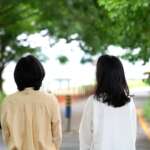
The South Korean woman who adopted her best friend
Seoul, South Korea – Most mornings, Eun Seo-Ran begins her day at around 7am by brewing tea for herself and her adopted daughter Lee Eo-Rie*. After a cup of black or herbal tea the two work in separate rooms – Seo-Ran as an essayist, while Eo-Rie studies for an exam. Around noon, they cook lunch, then sit down to eat and watch their favourite comedy series. Soon, the sound of them giggling fills the living room of their three-bedroom apartment. Outside, green cabbage fields stretch for miles. In the evening, the two eat dinner, and then do the household chores. On clear nights, the silhouette of a mountain gleams in the distance as they practise yoga before bed, chatting about…


